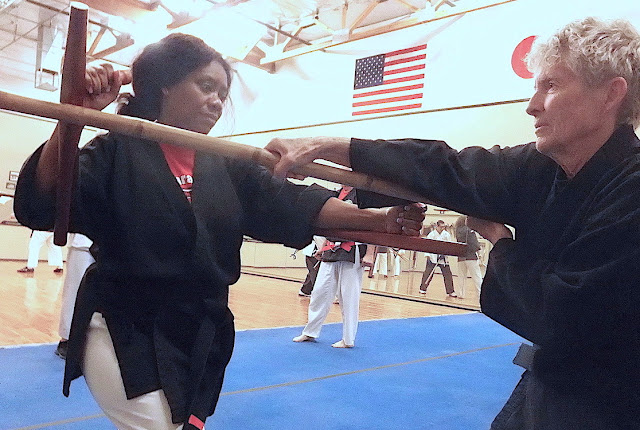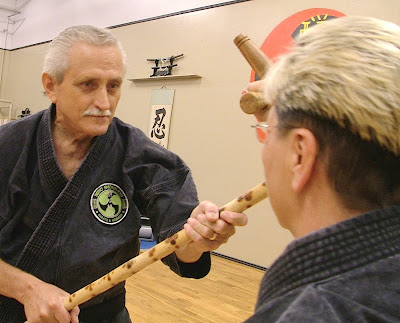Tonfa has an enigmatic history. Tools similar to the Okinawan tonfa are found in other Asian countries including China, Indonesia, Thailand and Philippines. Some suggest tonfa was developed in southeastern Asia and later introduced to Okinawa. Others argue the weapon is indigenous to Okinawa.
Mae Sun Sawk is a similar weapon developed in Thailand, and has a rope to wrap around the elbow. A Chinese version of tonfa, known as guai, roughly translates as crutch (or walking stick). Guai is thought to have originated in China prior to 700 BC. A variation of guai is made from iron and called ma guai (horse crutch). Having a close martial arts kinship, any connection between China and Okinawa must be considered.
%20Seiyo%20Shorin-Ryu%20Hombu,%20Mesa,%20AZ.JPG) |
| Demonstrating maewashi-ka (extended strike) following furi uchi (whipping strike) with tonfa. Seiyo Hombu in Mesa, AZ |
In combat, tonfa is gripped by the short perpendicular handle (nigiri) or by the longer main shaft (monouchi) away from the handle. When the handle is grasped, the shaft protects the forearm & hand during blocking, while the knob (tsukagashira) & (tsuka) protects the thumb. If the end of the shaft is held, the shaft can be used to ward off blows, and the handle used to hook an opponent's weapon, arm, leg or neck. Traditionally used in pairs, large amounts of energy can be imparted to the shaft of the tonfa when swinging the tool by the handle. The tonfa can also be held by the shaft to strike with the knob similar to a hammer. In some instances, handle knobs were made with points to impart greater damage. One can also thrust either end of the shaft (ushiro atama or zen atama) to strike.
 |
| Seiyo Shorin-Ryu Karate and Kobudo classes, Mesa and Gilbert, Arizona |
Some suggest the tonfa shaft should extend about one inch beyond the elbow for combat; however, the weapon need only extend to the tip of the elbow (or slightly less). The shaft is 20 to 24 inches in length. Three traditional grips of tonfa include: (1) natural (honte mochi), (2) reverse (gyakute mochi), and (3) special grip (tokushu mochi).
The tonfa is just one of many weapons in the arsenal of Okinawan kobudo (古武道). Okinawan kobudo is also referred to as Ryukyu kobujutsu (see koryu). Weapons of kobudo are thought to have connections with farmers, merchants & fishermen of Okinawa. It is a common belief that tools evolved into self-defense weapons used by peasants because of restrictions ordered by King Sho Shin and later by the Satsuma Samurai. However, modern martial arts scholars have been unable to verify this & some suggest karate & kobudo were restricted to the Pechin (samurai) caste, rather than the Heimin (commoner). But it is likely there was influence by both groups. The genius of Okinawan kobudo was the addition of kata which became an extension of karate & the same strikes & blocks used in kobudo were used in karate with minor modifications.
 |
| Grandpa defends Grandma's attack. |
For members of Seiyo no Shorin-Ryu Karate Kobudo Kai, learning tonfa is important and is considered to be an extension of our martial arts system. Members train in three tonfa kata and learn all of the bunkai (applications in the kata) along with kumite. Kumite typically matches tonfa against other kobudo weapon such as bo, kama, tanto, etc.
 |
| Jeff and Adam train in kumite during kobudo class at the Seiyo Shorin-Ryu Hombu in Mesa, Arizona. |
